
|
|
25 November, 1999
Thanksgiving on the Ice
After just one evening at Lake Bonney, our team buzzed down the valley to
Lake Hoare, flying in a Kiwi Air Force helicopter. I love the helo
rides. There's an urgency to lifting straight up into the air that demands
paying attention. Helos are the dragonflies of Antarctica. So, we're
flying to Thanksgiving dinner, and at one point in our ride, Sarah, who
was sitting up front in the loadmaster seat, exclaimed into her
microphone, "Wow! This is great! This is the first time I've actually had
a chance to see out!" The co-pilot grinned. "So, how about a little of
this?" Sarah asked him as she signaled a half loop with her hand. Now? the
two of us sitting perpendicular to her facing the side windows didn't hear
any of this. Suddenly, we found ourselves swinging around in a long arc
until we were face down, floating parallel to the ice for a few
breathtaking moments. Knowing the small amount of pressure it would take
to push open the windows in case of emergency, I was grateful for the seat
belts keeping me from plummeting through the glass. What a view!
We came to Lake Hoare to share a feast and to get some sampling work
done. The Weatherport on Lake Hoare shelters a fourteen-inch hole cut by
the four-person limnology (lake study) crew earlier in the season. They
drilled through twelve feet of ice using a gas-powered drill with a
four-inch bit. They were careful to stop before they punched through the
ice at the bottom, because if they did, water would have flowed up into
the hole and froze the drill bit in. In the ice-drilling business, the
process gets kind of complicated. Picture these next steps: Sitting on the
ice next to the hole is a gas-powered generator that heats glycol
(antifreeze) to hotter than boiling, then pumps it through an insulated
rubber hose until it comes to what is known as a "hot finger". A hot
finger is a four-foot long hollow tube coiled back on itself like a
twisted paper clip. It hangs from a rope, which is tied to a metal bar
that spans the narrow, open hole in the ice. The hot glycol flows through
the coils to melt the ice, then is eventually sucked up again, cooled. It
then goes back to the generator where it's re-heated and the process
starts anew. Slowly, over most of a day, the hot finger expands the hole
to almost fourteen inches diameter. It works from the lowermost ice
surface up. The hot finger can't be running out of the water, so when the
hole is almost completely melted out up near the surface, the last couple
of feet of ice are chipped out by hand. Crews melting holes need to be
extremely careful not to let any glycol escape from the system because it
would contaminate the water.

Weatherports are used throughout the Antarctic. This one is actually on Lake Bonney, below our camp, but we did our water sampling at Lake Hoare from a Weatherport identical to this one. The color red is used for visibility- it's hard to miss against the predominantly white backdrop of the continent.

The Matterhorn, as seen from outside the Lake Hoare Weatherport.

We are here to collect water column samples of phytoplankton and gases. To collect these samples, we use a Niskin bottle, which is a five-liter collecting bottle that has a trap door at each end. The bottle is connected to a metal cable controlled by a winch. The cable is marked in one-meter increments, with a double mark every ten meters. You send the bottle down to the selected depth with both ends open. When you are at depth, you shoot a "messenger", a heavy metal weight, down the cable. The messenger hits the upper end of the bottle, forcing both ends to snap shut. The moment it shuts, you can feel a tug on the line and see bubbles rising to the surface. Then you know you can pull the bottle up. We take samples at twelve pre-selected depths, approximately two meters apart, starting where water meets ice and continuing to almost twenty meters at the bottom of the lake.
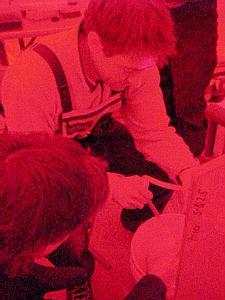
John L. and John P. working in the warm red glow of the Weatherport. John P. is regulating the flow of water from the Niskin bottle into a sample bottle by squeezing and releasing the rubber hose.
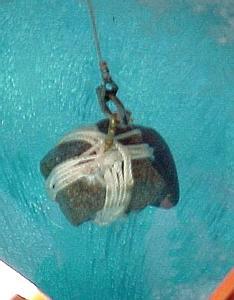
Attached to the bottom of the Niskin bottle is a lead weight, and tied to that was a rather large rock. This photo is the last anyone will ever see of the rock that Craig Wolf, the limnology team leader, so carefully tied on to keep the bottle from banging against the walls of the hole. After sending the bottle down a few times, we pulled it up once again and No rock. Gone forever. Craig will probably be sad, but at least he'll have this photo.
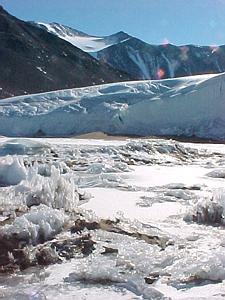
The Canada glacier originates in the Asgard Mountains and flows into the Taylor Valley, where it feeds into Lake Hoare.
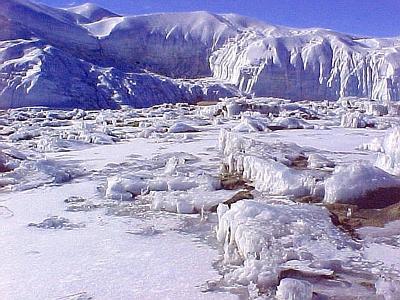
The strange ice formations on Lake Hoare are caused by sandy sediment from the Taylor Valley that is blown onto the frozen lake. The nearby Canada glacier acts as an immense wind break. Sediment being forced down the valley by powerful winds blow up against it and are boomeranged back to settle on the lake. The closer the glacier is, the more sediment tends to build up on the surface. Sediment absorbs heat from solar radiation and warms the ice underneath, melting irregular pockets into the surface. As they sediments sink deeper into the ice, the wind helps sculpt the ice left around the holes.
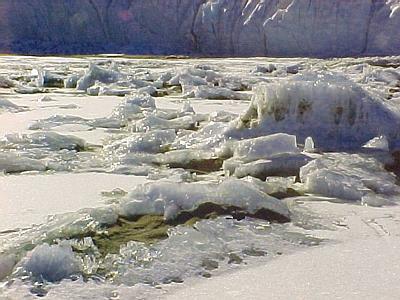
I walked from the Weatherport to the Lake Hoare camp by myself. As I became used to wearing my instep crampons with their long sharp fangs, I realized I was being tricked by sediment into believing there were hundreds of little islands of sand that reached all the way to the bottom of the lake. It was like walking over miniature mountain tops. I was beginning to think of the islands as safe havens for leapfrogging, rather than gingerly stepping on the places where the ice seemed thin. Half way across, I had to stop, look around, and remind myself that the sediment was actually a very thin coating on the surface of four feet of ice, which happened to be the only thing keeping me from plunging through twenty meters of frigid water. It was a humbling reminder to never take nature for granted.

Thanksgiving was great! There were almost 30 people at dinner. Researchers from throughout the valley came by helo or by foot because Rae, the camp manager and cook extraordinaire, is famous for coordinating a really amazing meal, even for those vegetarians among us. Patrick from McMurdo flew in to cook with her. Keep in mind there was no running water for washing up after dinner. Only an endless supply of glacial ice, ready to be chipped and melted, dirtied and stored.
Contact the TEA in the field at
.
If you cannot connect through your browser, copy the
TEA's e-mail address in the "To:" line of
your favorite e-mail package.
|
